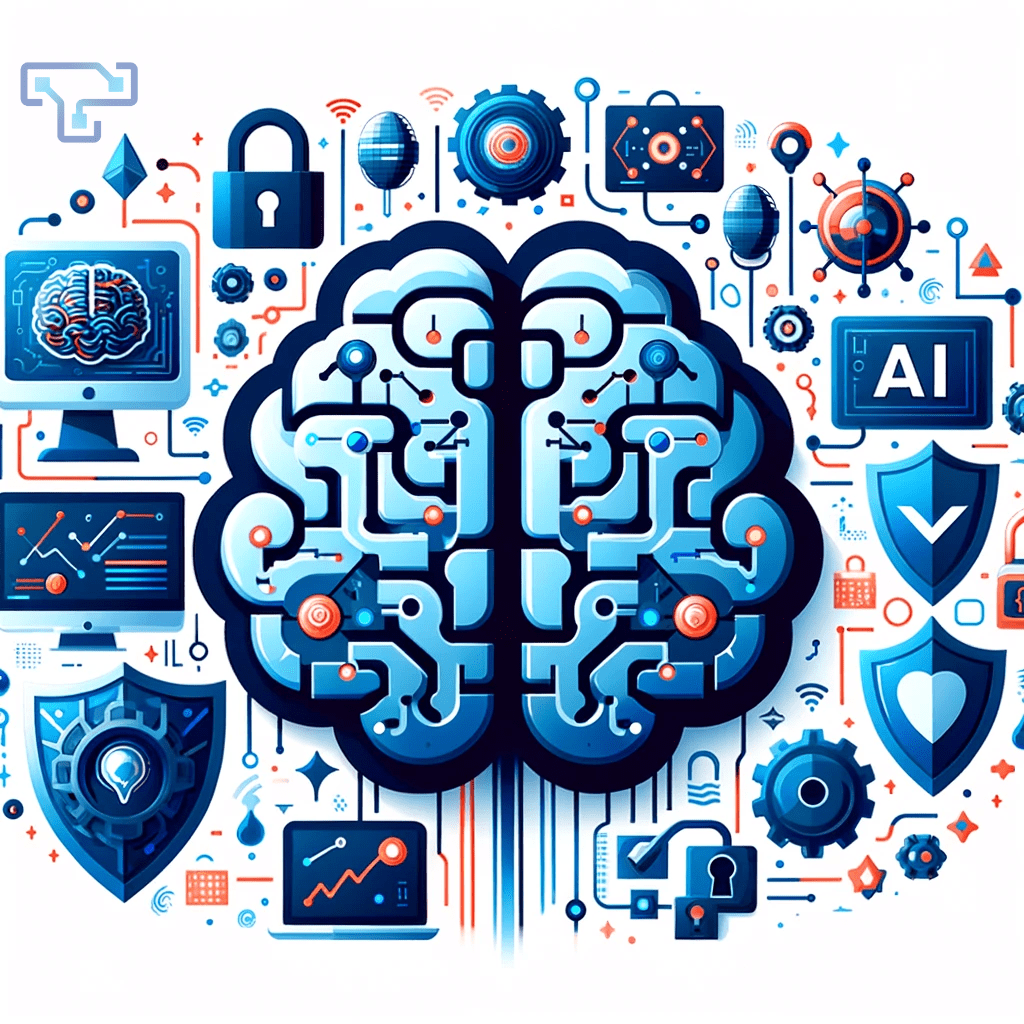AI in Cybersecurity: Enhancing Digital Defense
Introduction
The integration of AI in cybersecurity has revolutionized how organizations protect their digital assets. As cyber threats become more sophisticated, AI’s role in cybersecurity is increasingly vital. This article explores the applications, benefits, challenges, and future trends of AI in cybersecurity.
Understanding AI in Cybersecurity
Definition and Scope
Artificial Intelligence (AI) in cybersecurity refers to the use of AI technologies to enhance the protection of digital systems and data. AI encompasses various techniques such as machine learning, neural networks, and data mining to automate and improve cybersecurity measures.
Historical Context and Evolution
The evolution of AI in cybersecurity has been significant. Initially, AI was used for basic predictive analytics, analyzing historical data to forecast potential threats. Over time, its role has expanded to include real-time threat detection, user behavior analytics, and even generative AI for proactive defense strategies.
Basic Principles of AI in Cybersecurity
AI in cybersecurity operates on several core principles:
- Machine Learning (ML): Recognizing patterns and learning from past incidents.
- Natural Language Processing (NLP): Interpreting human language to streamline security tasks.
- Data Mining: Extracting valuable patterns and insights from large datasets.
- Predictive Analytics: Forecasting potential threats based on historical data.
- Behavioral Analytics: Monitoring user behavior to detect anomalies.
Key Applications of AI in Cybersecurity
Threat Detection and Prevention
AI excels in threat detection by:
- Pattern Recognition and Anomaly Detection: AI identifies unusual patterns in network traffic and user behavior that could indicate a threat.
- Real-Time Threat Analysis: AI processes vast amounts of data quickly, enabling the identification of threats in real-time.
- Examples of AI Tools: Tools like IBM QRadar and CrowdStrike Falcon use AI to enhance threat detection capabilities.
Incident Response and Mitigation
AI enhances incident response by:
- Automated Incident Response: AI reduces response times and improves accuracy in handling incidents.
- Real-Time Remediation Processes: AI provides step-by-step remediation instructions based on previous incidents, ensuring quick resolution.
Vulnerability Management
AI’s role in vulnerability management includes:
- Continuous Monitoring and Automated Scanning: AI continuously scans systems for vulnerabilities, ensuring ongoing protection.
- AI-Powered Severity Assessments: AI prioritizes vulnerabilities based on their potential impact, allowing organizations to address the most critical issues first.
Behavioral Analytics
Behavioral analytics is crucial for detecting insider threats. AI helps by:
- User and Entity Behavior Analytics (UEBA): Monitoring and analyzing user behavior to detect anomalies.
- Identifying Unusual Activities: Spotting potential insider threats or compromised accounts through abnormal behavior patterns.
AI-Assisted Threat Hunting
AI enhances threat hunting by:
- Combining Human and AI Capabilities: AI supports human threat hunters, making their work more efficient.
- Managed Detection and Response (MDR): AI provides threat prioritization and actionable insights, enabling quicker and more effective threat hunting.
Benefits of AI in Cybersecurity
The integration of AI in cybersecurity offers numerous benefits:
Enhanced Detection Capabilities
AI significantly enhances threat detection capabilities by leveraging machine learning and data analytics to identify patterns and anomalies in vast amounts of data. Traditional cybersecurity measures often rely on predefined signatures or rules to detect threats, which can be ineffective against new or evolving threats. AI, on the other hand, can:
- Identify Sophisticated Threats: AI algorithms can detect complex threats such as zero-day exploits and advanced persistent threats (APTs) that traditional methods might miss.
- Real-Time Analysis: AI can process data in real-time, providing immediate alerts about suspicious activities, which helps in mitigating threats before they cause significant damage.
Scalability and Efficiency
The scalability of AI allows it to handle large volumes of data across extensive networks efficiently. As organizations grow and their digital footprints expand, traditional security measures may struggle to keep up. AI addresses this challenge by:
- Automating Routine Tasks: AI can automate repetitive and time-consuming tasks such as log analysis, freeing up human analysts to focus on more complex issues.
- Handling Big Data: AI systems can analyze massive datasets quickly, providing comprehensive monitoring and protection for large-scale networks.
Adaptability to New Threats
One of the most significant advantages of AI in cybersecurity is its ability to adapt to new threats. AI systems continuously learn from new data, which allows them to:
- Evolve with Emerging Threats: Machine learning models can be updated with new threat intelligence, enabling them to recognize and respond to the latest cyber threats.
- Proactive Defense: AI can simulate potential attack scenarios, helping organizations to identify and address vulnerabilities before they can be exploited.
Improved Accuracy and Reduced Human Error
AI enhances the accuracy of threat detection and reduces the likelihood of human error. Human analysts can make mistakes, especially when dealing with large volumes of data. AI mitigates this by:
- Reducing False Positives: AI systems can more accurately differentiate between legitimate activities and potential threats, reducing the number of false positives and allowing security teams to focus on real threats.
- Consistent Performance: AI systems operate 24/7 without fatigue, ensuring consistent monitoring and analysis of security events.
Cost-Effectiveness and Resource Optimization
Implementing AI in cybersecurity can lead to significant cost savings and better resource allocation. Organizations can optimize their cybersecurity budgets and human resources by:
- Reducing the Need for Extensive Human Intervention: AI automates many routine cybersecurity tasks, which can reduce the need for large security teams and lower operational costs.
- Enhanced Resource Allocation: By automating low-level tasks, AI allows human analysts to focus on more strategic and high-impact activities, improving overall efficiency and effectiveness.
Cybersecurity Democratization
AI democratizes access to advanced cybersecurity tools, making high-level protection more accessible to smaller organizations that may lack extensive resources. Benefits include:
- Lower Barrier to Entry: AI-powered cybersecurity solutions are often easier to deploy and manage, reducing the complexity and cost associated with traditional security measures.
- Expert-Level Protection: Smaller organizations can leverage AI to achieve a level of protection that was previously only available to larger enterprises with dedicated security teams.
AI-Assisted Collaboration
AI fosters better collaboration between human analysts and automated systems, leading to more effective threat identification and resolution. Key aspects include:
- Enhanced Decision-Making: AI provides actionable insights and recommendations, helping analysts make informed decisions quickly.
- Streamlined Workflows: AI can simplify complex data analysis and streamline workflows, enabling security teams to respond more efficiently to threats.
In summary, the benefits of AI in cybersecurity are multifaceted, ranging from enhanced detection capabilities and improved efficiency to adaptability and cost-effectiveness. By integrating AI, organizations can significantly bolster their defenses against an ever-evolving threat landscape.
Challenges and Limitations of AI in Cybersecurity
Despite its benefits, AI in cybersecurity faces several challenges:
- Data Privacy and Ethical Concerns: The collection and processing of large amounts of data raise privacy issues.
- Over-Reliance on AI Systems: Depending too heavily on AI can be risky if the technology fails or is compromised.
- Potential for AI to Be Used Maliciously: Cybercriminals can leverage AI for sophisticated attacks.
- Skill Gaps and the Need for Human Oversight: Skilled professionals are necessary to manage and interpret AI outputs, and there is a shortage of such expertise.
Future Trends and Innovations
AI in cybersecurity is set to evolve with several key trends:
- Generative AI and Proactive Defense: AI can create simulated attacks to enhance defenses.
- Integration with Emerging Technologies: AI will increasingly work alongside technologies like blockchain, IoT, and quantum computing.
- Addressing the Cybersecurity Skills Gap: AI can compensate for the shortage of skilled cybersecurity professionals.
- Developing Stronger Authentication Methods: AI will enhance biometric authentication and behavioral analysis.
FAQs
What is AI in cybersecurity?
AI in cybersecurity refers to the use of artificial intelligence technologies, such as machine learning and data analytics, to enhance the protection of digital systems and data. It helps in automating threat detection, improving response times, and providing more accurate and efficient security measures.
How does AI improve threat detection?
AI improves threat detection by analyzing vast amounts of data to identify patterns and anomalies that indicate potential threats. This real-time analysis allows AI to detect sophisticated cyber threats that traditional methods might miss, thereby providing a more robust security posture.
Can AI completely replace human cybersecurity analysts?
AI cannot completely replace human cybersecurity analysts. While AI can automate routine tasks and handle large data volumes, human expertise is crucial for interpreting AI outputs, making strategic decisions, and handling complex or nuanced threats that require a deeper understanding.
What are the risks associated with using AI in cybersecurity?
The risks associated with using AI in cybersecurity include data privacy concerns, the potential for AI systems to be manipulated by cybercriminals, and the danger of over-reliance on automated systems without adequate human oversight. Ensuring ethical use and proper management of AI is essential to mitigate these risks.
How does AI help in vulnerability management?
AI helps in vulnerability management by continuously monitoring systems for weaknesses and automatically scanning for security vulnerabilities. It assesses the severity of these vulnerabilities and prioritizes them, providing actionable insights for timely remediation to prevent potential exploits.
Conclusion
The integration of AI in cybersecurity is crucial for protecting digital assets in an increasingly sophisticated threat landscape. While AI offers numerous benefits, it must be used responsibly and ethically, with a balance between AI and human expertise. Organizations should adopt AI technologies to enhance their cybersecurity measures and stay ahead of emerging threats.
By adopting AI technologies, organizations can significantly enhance their cybersecurity posture, effectively managing and mitigating threats in an ever-evolving digital landscape.




